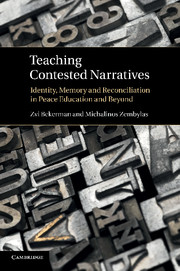Book contents
- Frontmatter
- Contents
- Acknowledgments
- Permissions
- Part I Introduction and theoretical underpinnings
- Part II Living and teaching contested narratives
- Part III Mourning, forgiveness and reconciliation
- Part IV Conclusions
- 11 Becoming critical design experts in schools
- 12 Memory and forgetting
- 13 De-essentializing identity
- 14 Designing different paths for reconciliation pedagogies
- References
- Index
14 - Designing different paths for reconciliation pedagogies
Published online by Cambridge University Press: 05 December 2011
- Frontmatter
- Contents
- Acknowledgments
- Permissions
- Part I Introduction and theoretical underpinnings
- Part II Living and teaching contested narratives
- Part III Mourning, forgiveness and reconciliation
- Part IV Conclusions
- 11 Becoming critical design experts in schools
- 12 Memory and forgetting
- 13 De-essentializing identity
- 14 Designing different paths for reconciliation pedagogies
- References
- Index
Summary
We often speak as if what we see and criticize is a result of a “mistake” in the system, and thus we are left with no option but to blame it on the system and/or the curriculum designers. But what if these things we do not like are not mistakes but “achievements” of the system – a system which wants to sustain conflict or the power of the nation state (or any other absolute master) untouched and for its own benefit? If we adopt this position, some will say that we are conspiracy theorists. We are not. We argue that the world is more complex than just a conspiracy. That is why more detailed research is needed. The more we know about details, the more we know about possibilities for change. The key to change is in knowing the details. The more we move away from the idea of psychologized perspectives of peace education into the materiality (i.e., the details) of conflict and peace, the better the chances we have for change, if change is what we are after.
The main points which have been raised in this book and run contrary to the accepted theory and practice in peace education are the following three. Firstly, the (at times) perceived failure – or dissatisfaction with the products – of peace education has little to do with the quality of individual teachers or students and much to do with the quality of the systems we (all) cooperatively construct. Failing to understand this means confusing failure with what are adaptive moves to local and global systemic circumstances.
- Type
- Chapter
- Information
- Teaching Contested NarrativesIdentity, Memory and Reconciliation in Peace Education and Beyond, pp. 224 - 230Publisher: Cambridge University PressPrint publication year: 2011



